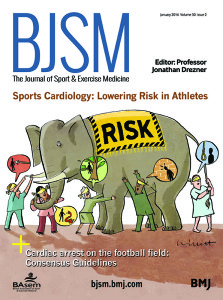Each week students in Professor Ian Shrier’s (@McGillU) Massive Open Online Course (MOOC) ask questions. One questions is answered by our world expert panel on the BJSM blog. This week’s question is from a MOOC student who used to run marathons. (not the person in the photo, left)
 Q: I used to be a marathon runner currently has 2+ mitral regurgitation and had past heart surgery including tricuspid valve repair. I am not asking your medical opinion (and I appreciate you cannot give me medical advice on a blog) but I wonder what principles underpin a cardiologist’s advice to runners who have had surgery and wonder if it will ever be safe to run a marathon again? (Underscore – this is an example for discussion, it is NOT medical advice for one person.
Q: I used to be a marathon runner currently has 2+ mitral regurgitation and had past heart surgery including tricuspid valve repair. I am not asking your medical opinion (and I appreciate you cannot give me medical advice on a blog) but I wonder what principles underpin a cardiologist’s advice to runners who have had surgery and wonder if it will ever be safe to run a marathon again? (Underscore – this is an example for discussion, it is NOT medical advice for one person.
Answer by Associate Professor André La Gerche, MBBS, PhD, FRACP, FCSANZ, FESC. Sports Cardiologist, Cardiology Department, St Vincent’s Hospital, Melbourne, Australia (Click to read Dr La Gerche’s key paper on right heart problems (members & library access) in high volume exercisers or listen to him chat (free) to Dr Michael Turner).
Note: Legal caveat. BJSM underscores that this is not ‘patient advice’ but discussion of a general question.
There are many different ways a heart valve may not be working well. Each has its own particular challenges that would influence recommendations for exercise, as well as personal history of previous heart surgery and other past medical or surgery history. However, there are some basic principles that are usually followed.
First, we want to avoid any factors that may exacerbate the condition and increase the chance of needing re-do surgery. The complexity of re-do surgery is always greater.
An important consideration is the distinction between “structural valve disease” such as problems with the valve leaflets or the papillary muscles that tether the valve in place as opposed to “functional” mitral valve regurgitation where the leakiness arises from dilation of the heart structures around the valve, but the valve itself is ok. There are some settings in which structural heart disease, such as severe mitral valve prolapse, may be exacerbated by strenuous exercise.
In general, in the absence of significant abnormalities with the valve structure and in the absence of left ventricular dilation or heart failure then it may be possible to exercise at any level and compete in all sports.
The American Heart Association Guidelines (Bonow et al. Circulation 2015) (OPEN ACCESS) suggest:
1. Patients with mild to moderate mitral regurgitation with normal heart size, function and pressures can participate in all competitive sports at all levels. This would include marathon running.
If there are 1) abnormalities in valve structure or 2) significant left ventricular dilation or dysfunction, then a thorough patient history, physical and investigations are required before advising patients on what might be considered a safe amount of exercise or intensity.
Here is the cover images for 2016 sports cardiology issue edited by @TheAMSSM ‘s Prof Jonathan Drezner
